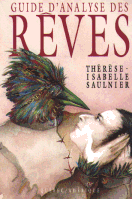by
Thérèse-Isabelle Saulnier
 |
In its present state, this site summarizes my book Guide d'analyse des rêves (A Guide to Dream analysis), Volumes 1 (Methodology) and 2 (Applications) published by Québec/Amérique in 1990 and 1993. The first part of Volume 1 explains the method of analysis. The second part, "Les symboles (ou éléments de rêve) les plus fréquents" (The most frequent dream symbols or elements), looks at the various meanings which different authors have given to such subjects as animals, numbers, body parts, the rooms in a house, clothes, etc., as well as meanings which can be logically attributed to them. Volume 2 contains 38 dream analyses which illustrate the method used. |
| A seventeen year old girl
dreams that she is on a boat with a friend. They're drawing in a shark, when a storm suddenly arises, the fishing-line breaks, the dreamer falls into the water and the shark, which is very angry with her, wants to eat her. Finally she emerges safe and sound (I'm leaving out the details of the dream). |
 |